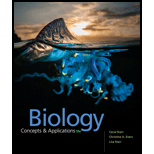
Concept explainers
Introduction:
The simplest level of organization is the chemical level of organization. This level of organization includes the building blocks called atoms through which life is possible on the earth. Different biologists and researchers gave the level of organization which is followed by every substance.
Answer to Problem 1SA
Correct answer:
Atoms are considered to be the smallest unit of all substances. Hence, the correct answer is option a.
Explanation of Solution
Reason for correct answer:
Option a. is given as “Atoms.”
The basic level of organization includes “atoms, molecules, cells, tissues, organs, organ system, organisms, population, community, ecosystem, and biosphere.” Therefore, the basic and smallest unit that forms all substances is an atom. The interaction of atoms results in the formation of molecules. Molecules interact to form cells. The cell is the basic “fundamental unit” of every living organism. The cellular interaction forms tissues and tissues link together to form organs. This formation cycle continues to grow and ultimately forms biosphere. The biosphere is the largest level of organization, and it contains all the substances (both living and non-living) that are present in the environment.
Reason for incorrect answer:
Option b. is given as, “Molecules.”
Molecules are one of the smaller units that form substances. However, they are not the smallest ones. Molecules are formed by the interaction of atoms with the help of
Option c. is given as, “Cells”.
Cells are the basic “fundamental unit” of life. They are the smallest unit for the formation of organisms but not substances. Cells are formed by molecules and molecules are composed of atoms. This indicates that cell is not the smallest unit of substance. Hence, option c. is incorrect.
Option d. is given as, “Organisms”.
Organisms are larger units. They contain cells, tissues, organ, and organ system. The basic unit that forms an organism is a cell. However, an atom is a smaller unit than cell. This indicates that organisms are not the smallest unit of substances. Hence, option c. is incorrect.
Hence, the options b., c., and d. are incorrect.
Atoms are the smallest units of substances. Every substance present in the environment is formed from atoms. Thus, the correct answer is option a.
Want to see more full solutions like this?
Chapter 1 Solutions
Bundle: Biology: Concepts and Applications, Loose-leaf Version, 10th + LMS Integrated MindTap Biology, 1 term (6 months) Printed Access Card
- please fill in the empty sports, thank you!arrow_forwardIn one paragraph show how atoms and they're structure are related to the structure of dna and proteins. Talk about what atoms are. what they're made of, why chemical bonding is important to DNA?arrow_forwardWhat are the structure and properties of atoms and chemical bonds (especially how they relate to DNA and proteins).arrow_forward
- The Sentinel Cell: Nature’s Answer to Cancer?arrow_forwardMolecular Biology Question You are working to characterize a novel protein in mice. Analysis shows that high levels of the primary transcript that codes for this protein are found in tissue from the brain, muscle, liver, and pancreas. However, an antibody that recognizes the C-terminal portion of the protein indicates that the protein is present in brain, muscle, and liver, but not in the pancreas. What is the most likely explanation for this result?arrow_forwardMolecular Biology Explain/discuss how “slow stop” and “quick/fast stop” mutants wereused to identify different protein involved in DNA replication in E. coli.arrow_forward
- Molecular Biology Question A gene that codes for a protein was removed from a eukaryotic cell and inserted into a prokaryotic cell. Although the gene was successfully transcribed and translated, it produced a different protein than it produced in the eukaryotic cell. What is the most likely explanation?arrow_forwardMolecular Biology LIST three characteristics of origins of replicationarrow_forwardMolecular Biology Question Please help. Thank you For E coli DNA polymerase III, give the structure and function of the b-clamp sub-complex. Describe how the structure of this sub-complex is important for it’s function.arrow_forward
 Medical Terminology for Health Professions, Spira...Health & NutritionISBN:9781305634350Author:Ann Ehrlich, Carol L. Schroeder, Laura Ehrlich, Katrina A. SchroederPublisher:Cengage Learning
Medical Terminology for Health Professions, Spira...Health & NutritionISBN:9781305634350Author:Ann Ehrlich, Carol L. Schroeder, Laura Ehrlich, Katrina A. SchroederPublisher:Cengage Learning Comprehensive Medical Assisting: Administrative a...NursingISBN:9781305964792Author:Wilburta Q. Lindh, Carol D. Tamparo, Barbara M. Dahl, Julie Morris, Cindy CorreaPublisher:Cengage LearningEssentials of Pharmacology for Health ProfessionsNursingISBN:9781305441620Author:WOODROWPublisher:Cengage
Comprehensive Medical Assisting: Administrative a...NursingISBN:9781305964792Author:Wilburta Q. Lindh, Carol D. Tamparo, Barbara M. Dahl, Julie Morris, Cindy CorreaPublisher:Cengage LearningEssentials of Pharmacology for Health ProfessionsNursingISBN:9781305441620Author:WOODROWPublisher:Cengage Human Biology (MindTap Course List)BiologyISBN:9781305112100Author:Cecie Starr, Beverly McMillanPublisher:Cengage LearningUnderstanding Health Insurance: A Guide to Billin...Health & NutritionISBN:9781337679480Author:GREENPublisher:Cengage
Human Biology (MindTap Course List)BiologyISBN:9781305112100Author:Cecie Starr, Beverly McMillanPublisher:Cengage LearningUnderstanding Health Insurance: A Guide to Billin...Health & NutritionISBN:9781337679480Author:GREENPublisher:Cengage





